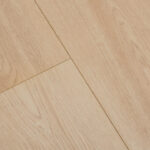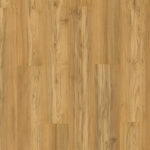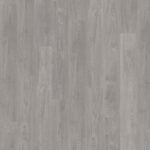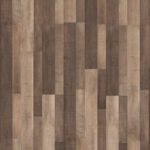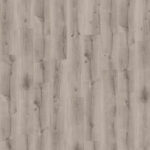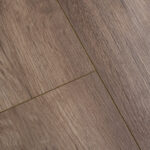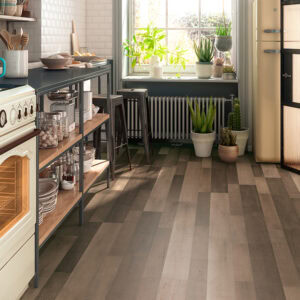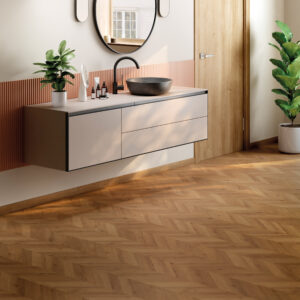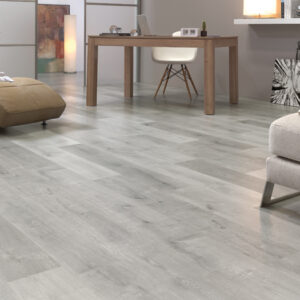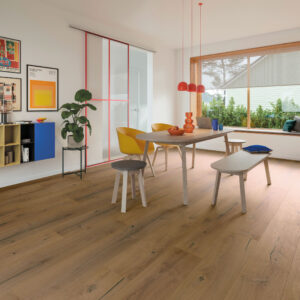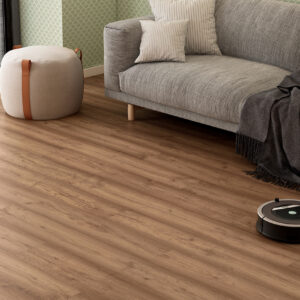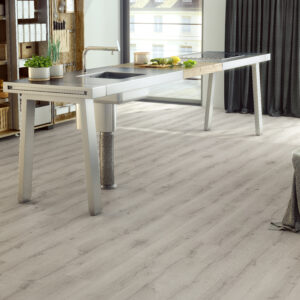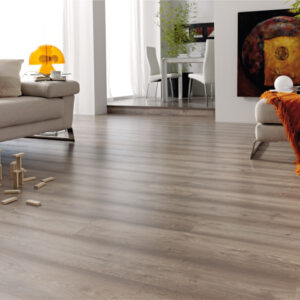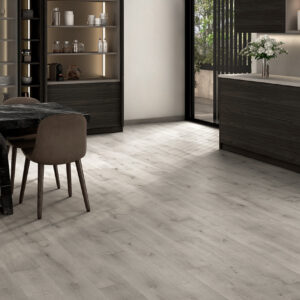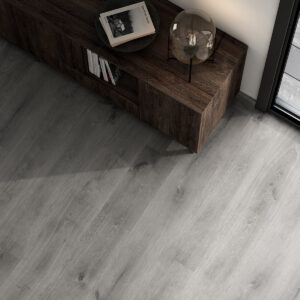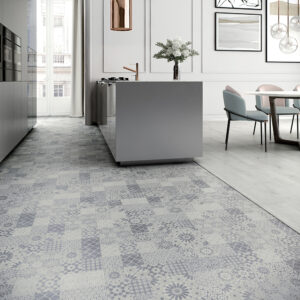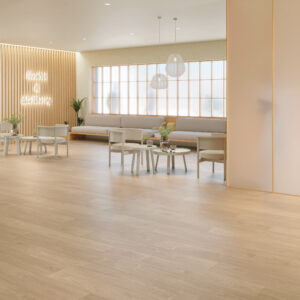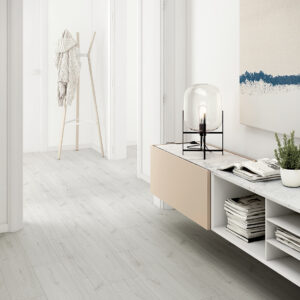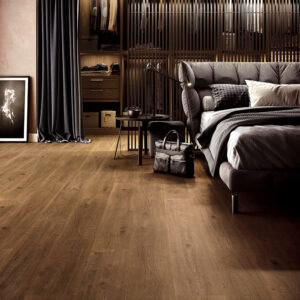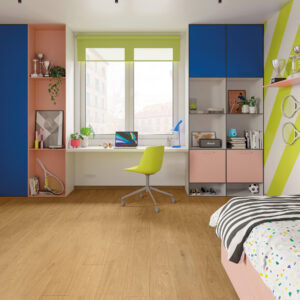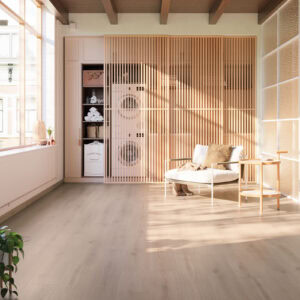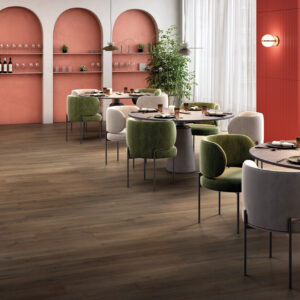Laminate Flooring
Laminate flooring is a top pick for property renovators and owners in the UK who want a contemporary, long-lasting, and affordable option compared to pricier hardwood or stone flooring.
Modern design innovations now mean that laminate flooring reproduces the look of wood and stone, making high-end finishes more approachable without the high prices.
One of the standout attractions of laminate flooring is that sections interlock easily, making it the go-to material for DIYers.
The wide range of laminate flooring products from trusted suppliers like Finsa means that quality can be yours at a cheaper price point. In the UK, searching ‘laminate flooring near me’ yields many results, making it a straightforward process to get the right product for you.
Let’s unpack this material and how it can transform your floors.
What Is Laminate Flooring Made Of?
Laminate flooring is a manufactured product that is intended to look like wood or stone. It is made up of the following:
- A transparent wear-protection top layer that lets you see the plank.
- The printed layer that copies the intended design.
- A high-density fibreboard (HDF) core to give it structure and moisture resistance.
- A bottom layer of melamine resin to protect from capillary action moisture.
Cheap laminate flooring now enjoys a top spot among flooring products, due to the following reasons:
- Affordable pricing without sacrificing quality or aesthetics.
- The click-into-place system for easy laying.
- Lowered maintenance costs compared to other flooring options.
- A durable but light and scratch-resistant construction, with some variants sporting antimicrobial features for enhanced hygiene.
Preparing The Floor for Laminates
If you are prepared for the job and understand the best practices, laminate flooring becomes a much simpler and timely process.
Let’s break it down:
- Start by cleaning the floor, removing the trim if any, and any baseboards you may have installed. Leave the room to dry fully before continuing.
- Check that each square meter of floor doesn’t have a deviation or bumps more than 2mm high. Remove or make flush with the floor any nails or screws that stick out and use a liqud leveler to smooth out any low places.
- For two full days before installation, store the laminates (outside the box) in the room you intend to have them in so they expand or contract to fit the target environment, making them easier to lay accurately.
- Ensure the underlay is flat and no edges overlap as you put it down and add moisture resistant silicone or waterproofing in bathrooms, basements, sinks, kitchens, etc., as you go.
- Take out the baseboards or trim for unobstructed access to the edges of the floor.
Installation of Laminate Floors
What tools will you need to get started? Let’s list them:
- An easy-to-use saw (jig, hand, or circular) and an undercut jamb saw.
- A sharp and sturdy utility knife.
- A hammer (for those pesky nails or screws) and rubber mallet (for the laminates).
- Tape measure.
- A pencil and T-square ruler.
- Wood spacers (you can make these yourself).
Now that you have all that, it’s installation time!
- Put down your first row of planks on the longest wall with about 10mm of space off the wall to allow for safe expansion and contraction during the floor’s lifecycle.
- If you need to cut the final piece to fit, measure the space first and transpose it on the plank for precision. Keep the cut-off to start the next row so it staggers the joints for a more aesthetic look.
- Fit the next row of planks into the first row at a 15-20° angle and ensure they fit onto each other before pushing them down to interlock the edges. Use the rubber mallet to nudge them in as you go.
- The last row of planks may need cutting, which you can do by measuring (don’t forget the expansion space) the space before laying them into place. Use a T-square for the length cuts to maintain precision.
- Finish the job with moulding around the edges to hide the expansion gap.
Special Considerations for Moisture-Prone Areas
Finfloor provides guidelines on how to install laminate flooring in high-moisture areas. Here are the best practices to keep in mind:
- Use waterproofing or sealant where moisture is common.
- Use specialised planks with sealed edges and water protection.
- If unsure of installation, ask a professional for help.
- Do not let spills sit on the laminates for long.
Join in and enjoy the benefits of high-quality laminate flooring UK homes and commercial spaces rely on.
Thickness Variations In Laminates
Finfloor boasts a diverse library of patterns to offer project managers design flexibility while keeping costs down.
8mm Laminate Flooring
Finfloor’s 8mm variants are lighter, cheaper, and DIY-friendly. Areas with moderate traffic (think studies, bedrooms, sitting rooms, etc.) benefit most from this plank.
12mm Laminate Flooring
Where you have the most traffic, you need thicker material for durability and soundproofing. The thickness of this material also produces more realistic designs, as they are etched in deeper.
Laminate Plank Sizes
Standard plank (Finfloor Original: 1331mm x 194mm x 8mm) – Balanced and classic look for contemporary interiors.
Narrow plank (Finfloor Style: 1310mm x 132mm x 8mm) – Sleek and space-enhancing, great for smaller or modern rooms.
Wide plank (Finfloor Supreme: 1310mm x 240mm x 8mm) – Adds a spacious feel to open-plan rooms and areas.
12mm plank (Finfloor 12: 1331mm x 194mm x 12mm) – Blends standard size with enhanced strength for better acoustics.
Types of Finishes for Laminate Flooring
Finsa’s catalogue is packed with a look for every room that you can source with a simple ‘laminate flooring near me Finsa’ search. They include:
- Tile Effect– Looks like ceramic or stone and stands out in kitchens, bathrooms, and entryways.
- Wood Impression– Add warmth and a touch of elegance to your sitting rooms and bedrooms.
- Tibet– A rustic oak aesthetic, perfect for libraries, cottages, and rustic-themed spaces.
- Vintage Matt– Aged finish for vintage-style appearances or high-end boutiques.
- Dover– Stone-textured; works well in kitchens, hallways, bathrooms, fireplaces, etc.
- Dry Touch– Matte and minimalist; perfect for Scandinavian-style interiors.
- Rustic Pore– Deep grain texture; a great fit for commercial spaces and minimalist interiors.
- Saw-Cut– Raw, unfinished look; also great for commercial or minimalist interior designs.
- Nature– The look of wood in nature; best for relaxing spaces that benefit from a grounded feel.
Where Laminate Flooring Is Most Commonly Used
Bedrooms and Living Rooms
Laminate flooring works well in living areas, with its scratch resistance and simple care instructions. Households with kids or pets do not have to worry about wear, except for scratches or gouges. DIY-friendly installation and cheaper pricing make it perfect for home renovations.
Bathrooms and Moisture-Prone Areas
Waterproofed sealed-edge planks are best for this use-case. It looks like stone or tiles and can handle moisture. The result is a sleek, low-maintenance alternative to vinyl or ceramic.
Commercial spaces
When buying laminate flooring UK for commercial spaces, regulations come into play. Pick the planks with a rating of Class 33 and AC6. They are built for spaces with higher-than-average foot traffic and are built to resist wear and impact.
Underfloor Heating Considerations
Laminate flooring works well with both electric and hydronic underfloor heating systems. For safe, effective use:
- Pick low thermal resistance laminates for good heat transfer.
- Don’t forget the expansion gaps during installation to allow for heat and humidity fluctuations.
- Keep surface temperatures below 27° to prevent heat damage (for example, warping).
- Buy underlays designed for underfloor heating installations for longevity.
Repairing Scratches and Other Damage on Laminate Flooring
Cheap laminate flooring maintenance follows best practices that account for its construction. Here is what you have to keep in mind:
- Sweep and vacuum to prevent dirt from forming layers and avoid using water when cleaning. Wipe with a damp cloth/towel instead.
- Spills seep into the edges and should be cleaned immediately.
- Never use wax, polish, or other harsh cleaners on the laminate, and keep your furniture on pads as they can gouge or scratch the floor when pushed.
If you need to fix scratches, you can use a colour-matched wax pencil as filler and delicately buff it.
Breakage or other severe damages are an easy fix too. Pull the affected plank and put in a new one.
Popular questions about laminate flooring.
How do I arrange laminate flooring?
Follow our installation process, which starts with prepping the floor, acclimating the planks to the room, and following best practices with the underlay, moisture-prone areas, measurement, and orientation.
For in-depth details, check out our installation guide.
How much is laminate flooring?
Good quality laminate flooring from our selection typically starts at a price of £17.69 per m2 and ranges up to £22.12 per m2.
How do I repair laminate flooring?
Scratches and gouges can be fixed with a colour-matched wax pencil or leveller/filler, while deeper cracks or breakages require replacement planks, which are easy to install.
Showing 1–32 of 35 results
-
8mm Laminated Flooring Paradise Oak 1310mm x 240mm (1.89m2 Pack)
Paradise Oak Laminated Flooring Finfloor Supreme features a blend of warm and cool oak tones arranged in a mixed-width plank design, creating a dynamic and character-rich aesthetic.
£36.57 £43.88 Inc VAT£19.35 Per M2 Add to cart -
8mm Laminated Flooring Orleans Chevron 1310mm x 240mm (1.89m2 Pack)
Orleans Chevron Laminated Flooring Finfloor Supreme features a natural oak tone arranged in a classic chevron pattern, bringing a sense of movement and timeless elegance to any space.
£36.57 £43.88 Inc VAT£19.35 Per M2 Add to cart -
8mm Laminated Flooring Nantes Chevron 1310mm x 240mm (1.89m2 Pack)
Nantes Chevron Laminated Flooring Finfloor Supreme features a warm caramel oak tone arranged in a classic chevron pattern, bringing a sense of movement and timeless elegance to any space.
£36.57 £43.88 Inc VAT£19.35 Per M2 Add to cart -
8mm Laminated Flooring Dijon Chevron 1310mm x 240mm (1.89m2 Pack)
Dijon Chevron Laminated Flooring Finfloor Supreme features a warm, golden oak tone arranged in a classic chevron pattern, bringing a sense of movement and timeless elegance to any space.
£36.57 £43.88 Inc VAT£19.35 Per M2 Add to cart -
8mm Laminated Flooring Toasted Selena Oak 1310mm x 132mm (1.73m2 Pack)
Toasted Selena Oak Laminated Flooring Finfloor Style features a warm, toasted oak tone with subtle grain patterns, creating a cozy and inviting atmosphere.
£33.47 £40.16 Inc VAT£19.35 Per M2 Add to cart -
8mm Laminated Flooring Sable Selena Oak 1310mm x 132mm (1.73m2 Pack)
Sable Selena Oak Laminated Flooring Finfloor Style features a soft, neutral oak tone with subtle grain patterns, creating a serene and inviting atmosphere.
£33.47 £40.16 Inc VAT£19.35 Per M2 Add to cart -
8mm Laminated Flooring Quercus Oak 1310mm x 132mm (1.73m2 Pack)
Quercus Oak Laminated Flooring Finfloor Style features a soft, neutral oak tone with subtle grain patterns, creating a timeless and versatile aesthetic.
£33.47 £40.16 Inc VAT£19.35 Per M2 Add to cart -
8mm Laminated Flooring Majestic Walnut 1310mm x 132mm (1.73m2 Pack)
Majestic Walnut Laminated Flooring Finfloor Style features a deep, rich walnut tone with an elegant and calm grain, offering a luxurious and timeless aesthetic.
£33.47 £40.16 Inc VAT£19.35 Per M2 Add to cart -
8mm Laminated Flooring Golden Selena Oak 1310mm x 132mm (1.73m2 Pack)
Golden Selena Oak Laminated Flooring Finfloor Style features a warm, golden oak tone with subtle grain patterns, creating a cozy and inviting atmosphere.
£33.47 £40.16 Inc VAT£19.35 Per M2 Add to cart -
8mm Laminated Flooring Artic Sovereign Oak 1310mm x 132mm (1.73m2 Pack)
Artic Sovereign Oak Laminated Flooring Finfloor Style showcases a soft, pale oak tone with subtle grey undertones, creating a serene and contemporary ambience.
£33.47 £40.16 Inc VAT£19.35 Per M2 Add to cart -
8mm Laminated Flooring Vintage Oak 1331mm x 194mm (2.07m2 Pack)
Tasmanian Teak Laminated Flooring Finfloor Original features a rich, medium-dark oak tone with softly darkened plank edges that accentuate room length and add a rustic charm.
£36.63 £43.96 Inc VAT£17.70 Per M2 Add to cart -
8mm Laminated Flooring Tasmanian Teak 1331mm x 194mm (2.07m2 Pack)
Tasmanian Teak Laminated Flooring Finfloor Original features a rich, medium-dark oak tone with softly darkened plank edges that accentuate room length and add a rustic charm.
£36.63 £43.96 Inc VAT£17.70 Per M2 Add to cart -
8mm Laminated Flooring Taupe Oak 1331mm x 194mm (2.07m2 Pack)
Taupe Oak Laminated Flooring Finfloor Original features a rich, medium-dark oak tone with softly darkened plank edges that accentuate room length and add a rustic charm.
£36.63 £43.96 Inc VAT£17.70 Per M2 Add to cart -
8mm Laminated Flooring Siddharta Walnut 1331mm x 194mm (2.07m2 Pack)
Siddharta Walnut Laminated Flooring Finfloor Original features a rich, medium-dark oak tone with softly darkened plank edges that accentuate room length and add a rustic charm.
£36.63 £43.96 Inc VAT£17.70 Per M2 Add to cart -
8mm Laminated Flooring Retro Oak 1331mm x 194mm (2.07m2 Pack)
Retro Oak Laminated Flooring Finfloor Original features a rich, medium-dark oak tone with softly darkened plank edges that accentuate room length and add a rustic charm.
£36.63 £43.96 Inc VAT£17.70 Per M2 Add to cart -
8mm Laminated Flooring Polka Oak 1331mm x 194mm (2.07m2 Pack)
Polka Oak Laminated Flooring Finfloor Original features a rich, medium-dark oak tone with softly darkened plank edges that accentuate room length and add a rustic charm.
£36.63 £43.96 Inc VAT£17.70 Per M2 Add to cart -
8mm Laminated Flooring Paramount Oak 1331mm x 194mm (2.07m2 Pack)
Paramount Oak Laminated Flooring Finfloor Original features a rich, medium-dark oak tone with softly darkened plank edges that accentuate room length and add a rustic charm.
£36.63 £43.96 Inc VAT£17.70 Per M2 Add to cart -
8mm Laminated Flooring Obelisque Oak 1331mm x 194mm (2.07m2 Pack)
Obelisque Oak Laminated Flooring Finfloor Original features a warm, natural oak tone enriched with well-defined knots and subtle cracks, delivering a rustic and authentic wood appearance.
£36.63 £43.96 Inc VAT£17.70 Per M2 Add to cart -
8mm Laminated Flooring Lofoten Pine 1331mm x 194mm (2.07m2 Pack)
Lofoten Pine Laminated Flooring Finfloor Original features a soft, whitewashed pine tone with subtle sandy undertones, creating a clean and fresh atmosphere in any interior.
£36.63 £43.96 Inc VAT£17.70 Per M2 Add to cart -
8mm Laminated Flooring Kilimanjaro Oak 1331mm x 194mm (2.07m2 Pack)
Kilimanjaro Oak Laminated Flooring Finfloor Original features a light grey neutral tone with subtle beige undertones, offering a rustic yet contemporary aesthetic.
£36.63 £43.96 Inc VAT£17.70 Per M2 Add to cart -
8mm Laminated Flooring Glamour Oak 1331mm x 194mm (2.07m2 Pack)
Glamour Oak Laminated Flooring Finfloor Original features a warm, natural oak tone with subtle grain patterns, creating a cozy and inviting atmosphere.
£36.63 £43.96 Inc VAT£17.70 Per M2 Add to cart -
8mm Laminated Flooring Columbia Oak 1331mm x 194mm (2.07m2 Pack)
Columbia Oak Laminated Flooring Finfloor Original features features a luminous light grey tone with a rustic style, incorporating cathedral-type patterns into its design with a gentle sense of movement.
£36.63 £43.96 Inc VAT£17.70 Per M2 Add to cart -
8mm Laminated Flooring Calcic Oak 1331mm x 194mm (2.07m2 Pack)
Calcic Oak Laminated Flooring Finfloor Original features features a luminous light grey tone with a rustic style, incorporating cathedral-type patterns into its design with a gentle sense of movement.
£36.63 £43.96 Inc VAT£17.70 Per M2 Add to cart -
8mm Laminated Flooring Bromo Oak 1331mm x 194mm (2.07m2 Pack)
Bromo Oak Laminated Flooring Finfloor Original features a dark grey tone with subtle cathedral grain patterns, offering a rustic yet refined aesthetic.
£36.63 £43.96 Inc VAT£17.70 Per M2 Add to cart -
8mm Laminated Flooring Banff Oak 1331mm x 194mm (2.07m2 Pack)
Banff Oak Laminated Flooring Finfloor Original features a warm, natural oak tone with subtle grain patterns, creating a cozy and inviting atmosphere. The synchronized texture aligns with the wood grain, providing a realistic and natural feel.
£36.63 £43.96 Inc VAT£17.70 Per M2 Add to cart -
8mm Laminated Flooring Alfama Tile 1331mm x 194mm (2.07m2 Pack)
Alfama Tile Laminated Flooring Finfloor Original features a soft, neutral stone-inspired tone with a subtle matte finish.
£36.63 £43.96 Inc VAT£17.70 Per M2 Add to cart -
12mm Laminated Flooring Essence Kalmar Oak 1331mm x 194mm (1.55m2 Pack)
Kalmar Essence Oak Laminated Flooring Finfloor 12 comes in a light beige shade with a hint of grey and some natural-looking knots. The texture of laminated flooring Kalmar Essence feels just like real oak wood, so it not only looks good but feels natural too.
£34.29 £41.15 Inc VAT£22.12 Per M2 Add to cart -
12mm Laminated Flooring Albar Kalas Oak 1331mm x 194mm (1.55m2 Pack)
Albar Kalas Oak Laminated Flooring Finfloor 12 features a soft white oak tone with subtle cracks and knots, bringing a sense of brightness and natural charm to any interior.
£34.29 £41.15 Inc VAT£22.12 Per M2 Add to cart -
12mm Laminated Flooring Toasted Wexford Oak 1331mm x 194mm (1.55m2 Pack)
Toasted Wexford Oak Laminated Flooring Finfloor 12 features a warm, medium oak tone enriched with natural imperfections like cracks and knots, capturing the authentic character of aged wood.
£34.29 £41.15 Inc VAT£22.12 Per M2 Add to cart -
12mm Laminated Flooring Golden Viena Oak 1331mm x 194mm (1.55m2 Pack)
Golden Viena Oak Laminated Flooring Finfloor 12 features a toasted oak tone with distinctive cathedral grain patterns, adding character and warmth to any space.
£34.29 £41.15 Inc VAT£22.12 Per M2 Add to cart -
12mm Laminated Flooring Twilight Oak 1331mm x 194mm (1.55m2 Pack)
Twilight Oak Laminated Flooring Finfloor 12 features a warm, toasted oak tone with subtle grey undertones. Creates a very inviting atmosphere for your rooms.
£34.29 £41.15 Inc VAT£22.12 Per M2 Add to cart -
12mm Laminated Flooring Noz Kalas Oak 1331mm x 194mm (1.55m2 Pack)
Noz Kalaz Oak Laminated Flooring Finfloor 12 muted soft oak shade with gentle natural tones that lend a timeless, elegant look to any interior.
£34.29 £41.15 Inc VAT£22.12 Per M2 Add to cart
